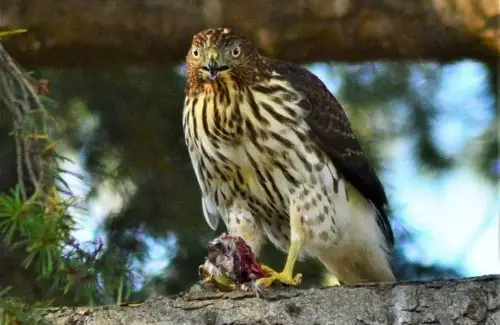Other than being known as one of the American states with the highest population density, New Jersey is home to a wide range of raptors, including hawks, owls, and eagles. In fact, over 150 raptors are spotted in New Jersey every month.
For the sake of time, we will only focus on the birds that can attain over 150 miles per hour when going after their prey. Therefore, whether transient migrators or permanent residents, only seven hawks seem to rule the skies in New Jersey.
The 7 Common Hawks in New Jersey
Hawks are very strong birds with curved and sharp talons for catching prey before tearing them apart using their hooked beaks. Plus, their eyesight and sense of hearing are what make them exceptional and great birds to behold.
Their sight is actually eight times better than that of human beings; in fact, the Sharp-shinned hawk is the smallest hawk in New Jersey, while the Rough-legged hawk is the largest. These huge hawks can even feed on small birds.
Some of the most popular hawks in New Jersey include the following:
1. The Northern Goshawk
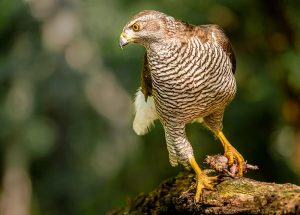
Other than their size, they are identified by 1 of 2 color combinations (brownish-grey or blue-grey). This bigger, fiercer, and wilder bird of prey belongs to the eagles' family.
Unlike most raptors, the Northern goshawks are well-established raptors that most folks use to falconry, which means that they use them for hunting small mammals.
Spotted in winter in this state, the Northern Goshawk resides in the deepest parts of the forest where they can't be traced.
They're secretive birds and can be very aggressive when confronted; after all, the Northern goshawks are very territorial birds that love defending their territory. Plus, they can lay up to 5 eggs per season.
Thanks to their size and fierceness, the Northern goshawk has very few predators, but the juvenile and nestling are usually preyed on by eagles.
They feed on squirrels, crows, wood pigeons, rabbits, and other smaller birds.
2. Cooper's Hawk
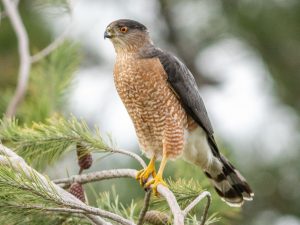
Another common New Jersey hawk that can be found all over North America is Cooper's hawk. This medium-sized raptor, which was first described by William Bartram in 1791, is known for its small hooked bill and wedge-like tail. This bird belongs to the genus Accipiter, which is at times known as the true hawks; in fact, Cooper's hawk's scientific name is Accipiter cooperii.
Unfortunately, identifying hawks can be quite challenging since they resemble each other. The Cooper's hawk resembles the sharp-shinned hawk and northern goshawk.
In fact, distinguishing them can be quite challenging as they have blue-gray back, red-orange breasts, and black-banded tail feathers. Cooper's hawks have a white underside and blackish-brown, blue-gray, or brown feathers.
Just like most raptors, Cooper's hawk can be found on the edge of the forests, where they can easily ambush their prey. They mainly feed on small mammals and chickens, plump fowl, and quails, among other birds.
Plus, their unique camouflaged feathers help with their hunting technique as they help them hide among the branches.
Unlike most raptors, Cooper's hawk loves taking their prey by surprise instead of engaging them in a long pursuit; therefore, they love keeping their distance for some time.
Their key predators of the coopers hawk include eagles and some huge preying birds, but their major issue is the pesticides that have destroyed many hawks for decades.
3. Sharp-Shinned Hawk
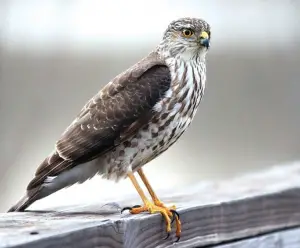
The Sharp-shinned hawk is another incredible hawk with a small head that's barely visible when it's flying. They're small, long-tailed hawks with square-tipped tails and round wings. But the females are a bit bigger than the males.
The adult sharp-shinned hawks have red-orange breasts and a grayish-blue top. On the other hand, the young ones are usually brown with some broad darker bands across their tails like an adult. Plus, they have an exceptional flap-and-glide flying technique.
Interestingly, the sharp-shinned hawk is that it can fly at extremely high speed, even through a dense forest, just to catch its prey.
Its diet comprises quails and songbirds, but the sharp-shinned hawk can also consume rodents, squirrels, frogs, snakes, and insects.
They can be found in the deepest parts of the forests and can even be seen high in an open habitat or in the sky. And like other hawks, the sharp-shinned hawk loves building its nest on conifer trees, particularly on tall trees with dense cover.
4. Broad-Winged Hawk

Even though it's quite hard to spot this hawk since the broad-winged hawks live in the deep woods, these hawks live everywhere in New Jersey. But the best time to spot a broad-winged hawk is in the fall when they'll be migrating in huge numbers.
They're medium-sized raptors with stocky, compact bodies like crows and geese.
The unique thing about broad-winged hawks is that their broad wings seem small when perched, but the tail outmatches them. But as soon as the broad-winged hawk takes off, you will be surprised by their wings' pointed tips and size.
It's dark in appearance with a pale underside and brownish feathers. Unfortunately, they're too timid and tend to avoid human beings even though they can be seen roaming in the skies.
Fun Fact: Did you know that falcons resemble hawks in some ways? Read about this in the falcon vs hawk article on this site.
5. Red-Shouldered Hawk
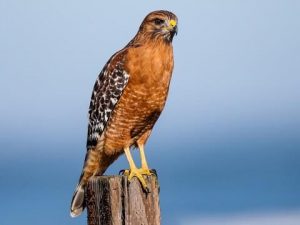
Even though most hawks have red-feathered shoulders, the Red-shouldered hawk has more features that make it unique. For example, the redness on this hawk's shoulder stretches to the chest while its underside is pale.
Like the broad-winged hawk, the Red-shouldered hawk comes with a red-tinted chest. But the red-shouldered hawks have pale-colored feathers, and the wings of the broad-winged hawk are pointier.
Interestingly, the red-shouldered hawk is one of the noisiest birds on the planet, and it can get noisier when trying to attract a mate.
Like the Red-shouldered hawk's scientific name (Buteo lineatus) suggests, it belongs to the Buteo family of hawks.
Plus, the Red-shouldered hawks love hunting in the forest's undergrowth, where they feed on snakes, small mammals, frogs, and lizards.
6. Red-Tailed Hawk
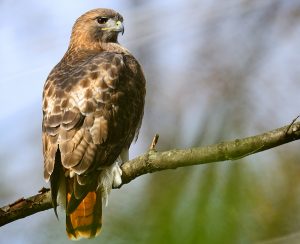
There are many hawks in New Jersey, but nothing is as common as the Red-tailed hawk. As the Red-tailed hawk's scientific name suggests, it is one of the most common Buteo hawks that love foraging for food in grasslands or trees, especially in winter.
Sometimes you can find it soaring high in the sky. You can even find them hunting in the evening and morning hours.
Fortunately, they're not migratory creatures, so they remain in the same region for years.
Therefore, you can find the Red-tailed hawks all year round in this state. Even though the Red-tailed hawks are native to North America, they have been expanding their territory to Asia.
Thanks to climatic changes that have affected the food supply, these hawks can be found in Japan. Climatic changes have forced them to migrate to Asia in search of food.
Unlike most birds, the Red-tailed hawk has beta-keratin in its feathers, so as they age, it oxidizes, resulting in its color darkening with time. This is actually the main reason why they turn black after living for over 12 months.
Like most hawks, the Red-tailed hawk is known for its 4-foot wingspan that allows it to fly through the air effortlessly.
These raptors are carnivores; therefore, the Red-tailed hawks can consume anything they can kill. They tend to eat ground squirrels, rats, and mice, but occasionally, they can eat huge animals like snakes and rabbits.
7. Rough-Legged Hawk
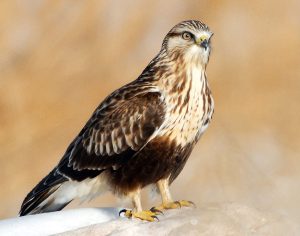
New Jersey is home to some of the largest buteo hawks on the planet, and the one that calls this state home is the Rough-legged hawks. This all-American bird can be found in North America and the northern parts of South America.
It has a narrow trunk and fairly broad wings; plus, the rough-legged hawk spots some dark brown feathers on its tail and back.
During the breeding season, which starts in March, the males help build the nests on cliff sides by gathering the building materials.
These birds can be found all year-round in New Jersey, but they're way more common in winter.
They feed on other birds, voles, and lemmings. In fact, you can see a rough-legged hawk hunting from a flight or a perch with its rapid wing beats that are interspersed with glides.
Watch This!
Frequently Asked Questions
Is the Sharp-Shinned Hawk Protected in New Jersey?
Generally, there are a number of endangered hawk species in New Jersey that are protected by the state, and this includes the sharp-shinned hawk. Fortunately, the Sharp-shinned hawk is not an endangered species.
What Is the Biggest Hawk in New Jersey?
The largest hawk in New Jersey is the Rough-legged hawk which can be found hunting for prey all over the state. On the other hand, the sharp-shinned hawk is actually the smallest hawk in NJ.
What Is the Most Common Hawk in New Jersey?
NJ is home to a wide range of hawks that can be seen soaring high in this state's skies but the most common hawk is the sharp-shinned hawk. The sharp-shinned hawks can be found preying or hunting songbirds feeding on our backyard bird feeders.
Are Northern Harriers Common in New Jersey?
Yes, the Northern harrier is one of the most common hawks in New Jersey. In fact, the fact that they resemble great horned owls means that they're very easy to spot.
But the wintering population of the Northern harriers is stable, but its breeding population is considered endangered. In the 1980s, the breeding population of the Northern Harrier in this state was about 50 pairs.
Conclusion
New Jersey is home to a number of hawk species; in fact, most of the native species can be found in this state, with some being in this state all year round. Unfortunately, these hawks have a wide range of similarities which makes it almost impossible for the locals to differentiate one species from the other.
But with the above descriptions, you can attract certain hawk species to your bird feeder with the other birds. In fact, Cooper's hawk can spend hours in the woods waiting for prey.

